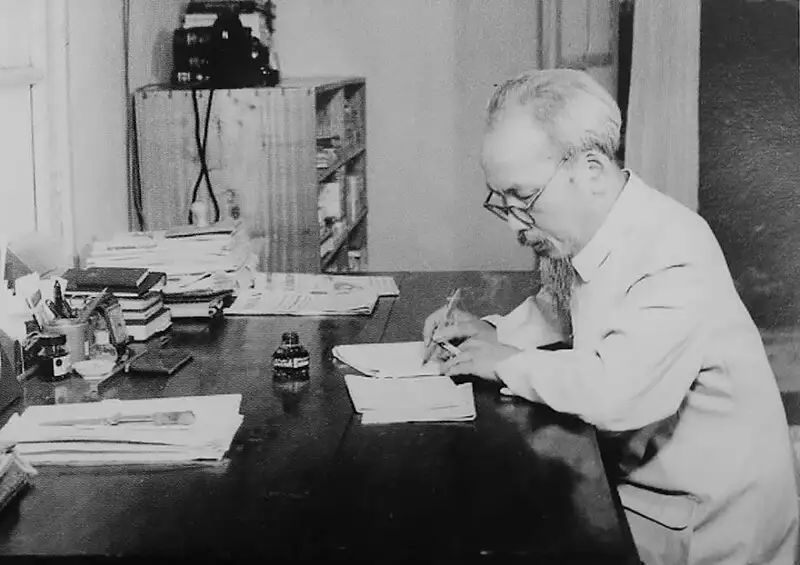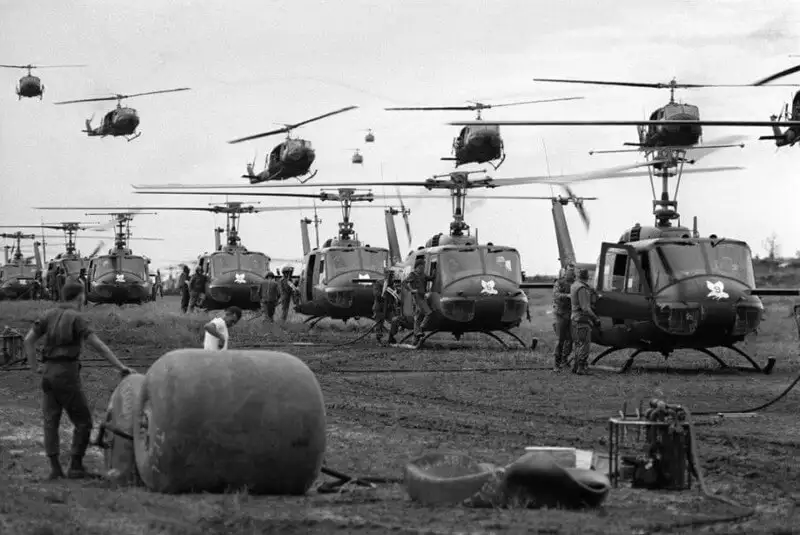The Vietnam War is widely regarded as a confrontation between the communist North and the Western-leaning South. However, it wasn’t just the Vietnamese who fought in this conflict. Numerous countries, particularly the United States, intervened directly by supplying troops, weapons, and logistics, primarily to support South Vietnam. This transformed an internal conflict into a ferocious Cold War battlefield.
In this article, Pywar will list the countries that invaded Vietnam as well as Vietnam’s allies during the war, along with the motivations driving their involvement.
France
Before 1954, France had been a long-standing occupying power in Vietnam, but after its defeat at Dien Bien Phu, the nation had no desire to engage in the subsequent conflict.
After World War II, France reoccupied Vietnam as part of an effort to restore its pre-war colonial empire. According to Professor of History Ed Moise from Clemson University, author of Tonkin Gulf and the Escalation of the Vietnam War, “France had controlled Vietnam for generations and was determined to maintain that control, both out of national pride and fear that if one colony gained independence, others would follow.”
However, the majority of Vietnamese people opposed colonial rule, leading to the rise of an insurgency movement led by Ho Chi Minh, a communist and independence advocate. In 1954, Ho Chi Minh’s forces secured a decisive victory at Dien Bien Phu, forcing France to withdraw completely from Vietnam.
When the Second Indochina War (known to Americans as the Vietnam War) broke out shortly afterward, France chose to stay out of it. In fact, French President Charles de Gaulle warned his U.S. counterpart, John F. Kennedy Jr., that Vietnam would become a “bottomless political and military quagmire.” Though this prediction proved accurate, the advice went unheeded.
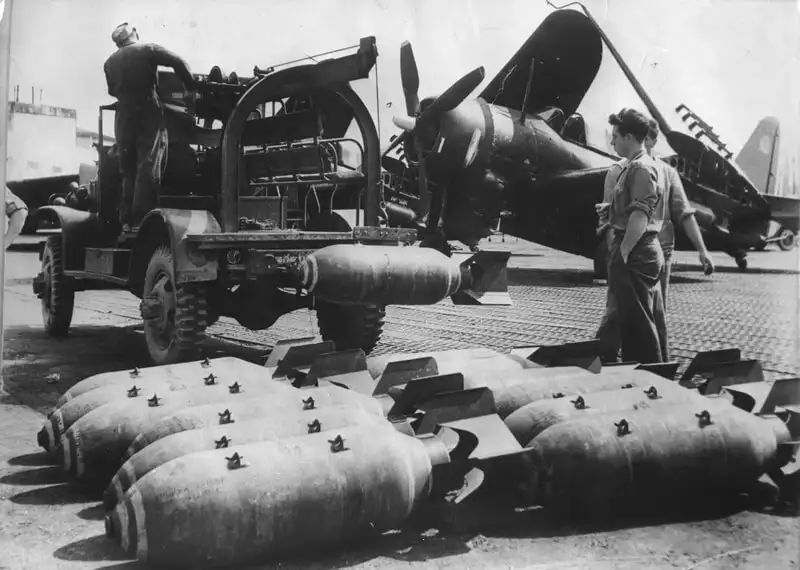
- Bombs being prepared for French aircraft during the Battle of Dien Bien Phu, a pivotal event in the First Indochina War, April 10, 1954. (Source: Collected)
The United States
The United States entered the Vietnam War to prevent South Vietnam from falling to communism. Initially, its involvement was limited to behind-the-scenes support, but after 1964, the U.S. began deploying combat troops and became increasingly entrenched in the conflict.
Following France’s defeat in the First Indochina War, an international agreement split Vietnam into two regions. The North was led by Ho Chi Minh, while the South was governed by Ngo Dinh Diem, backed by the U.S. The plan was for both regions to hold elections within two years to reunify the country. However, fearing defeat, Diem, with U.S. approval, refused to hold the elections. Instead, a communist insurgency, known as the Viet Cong and supported by the North, erupted against Diem’s regime.
Determined to shield South Vietnam from the spread of communism, the United States provided billions of dollars in aid and increased the number of military advisors to Diem’s government. As the later-released Pentagon Papers revealed, “the Diem regime, and almost certainly an independent South Vietnam, could not have survived without U.S. assistance.”
Initially, U.S. officials grew disillusioned with Ngo Dinh Diem and tacitly supported the 1963 coup that led to his death. However, American support for South Vietnam remained unwavering, regardless of who occupied the White House.
According to Professor of Political Science James McAllister from Williams College, “No one thought they would win, but they were certain that defeat wouldn’t happen on their watch.”
At first, the U.S. operated largely behind the scenes. However, the Gulf of Tonkin Incident in 1964 prompted President Lyndon B. Johnson to deploy combat troops and launch a massive bombing campaign. From then on, U.S. involvement deepened significantly.
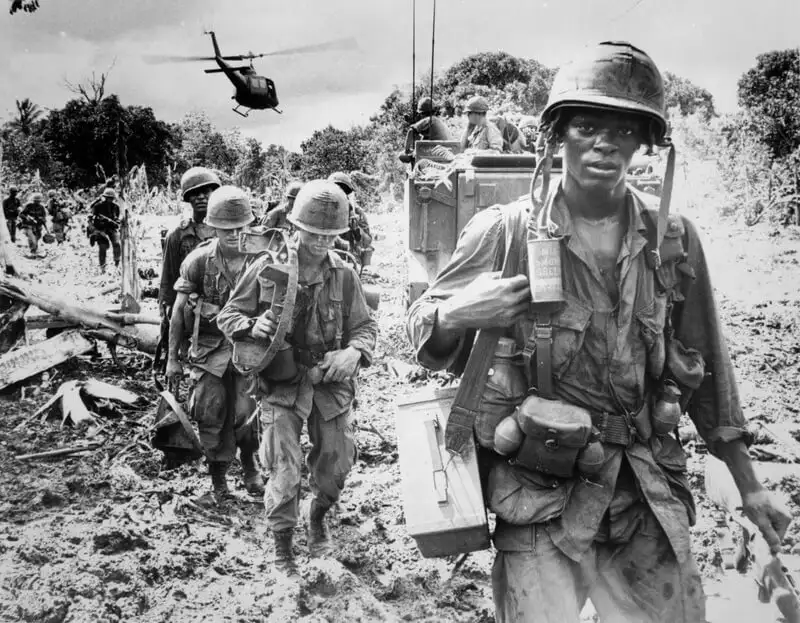
- American soldiers during a campaign on the Vietnam battlefield, evidence of the U.S.’s extensive intervention in the Vietnam War. (Source: Collected)
By the time U.S. forces withdrew from Vietnam in 1973, approximately 2.7 million American troops had served, over 58,000 had died, and the country had incurred a staggering cost of at least $111 billion (not including billions more in non-military expenses).
Though the experiences of France and the U.S. in Vietnam differed in many ways, both learned a crucial lesson. As Professor Ed Moise noted: “It’s dangerous to enter a war where the enemy has greater determination to win than you do.”
China
From its early days as a communist state, China supported Ho Chi Minh in the war against France and continued this assistance during the conflict with the United States. Despite economic hardships, China supplied weapons, experts, and manpower to North Vietnam. In total, China claims to have spent over $20 billion and deployed 320,000 troops, of whom more than 4,000 perished.
Much of China’s role was behind the scenes, focusing on rebuilding areas devastated by U.S. bombs and operating anti-aircraft artillery batteries. However, its most significant contribution may have been deterrence: China warned that if U.S. forces invaded North Vietnam, it would respond in kind.
Unlike in the Korean War, this time the U.S. yielded to China’s threat. According to Professor Ed Moise, “They acted as a tripwire, sending a message to the U.S.: ‘Don’t go too far… or you’ll face us.’”
China and the Soviet Union didn’t need to invest as heavily as the U.S. because they were supporting the stronger side. However, Professor Moise emphasizes that without aid from China and the Soviet Union, North Vietnam could not have prevailed. This is especially evident when considering that the U.S. military budget was roughly 30 times larger than North Vietnam’s entire GDP.
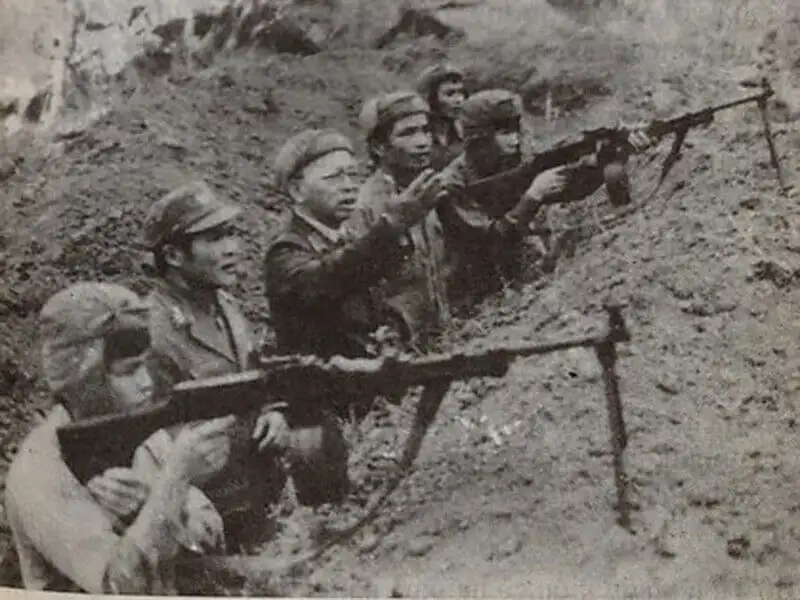
- Chinese soldiers training and supporting North Vietnam during the wars against France and the U.S. (Source: Collected)
The Soviet Union
As the world’s first communist state, the Soviet Union aided North Vietnam, particularly intensifying its support in the late 1960s. While it provided some troops, its greatest contribution was weaponry.
Initially, the Soviet Union showed little interest in the Vietnam War. However, after Nikita Khrushchev’s ouster, it secretly ramped up aid to the North. According to Professor James McAllister, the Soviets aimed to “make life difficult for the United States,” but they took care to avoid actions that could spark a direct confrontation with the superpower.
Soviet involvement grew in the late 1960s, as China’s influence waned amid rising tensions between the two nations. The Soviets supplied advanced weapons, including surface-to-air missiles that China couldn’t yet produce. Some reports suggest Soviet forces even shot down U.S. aircraft. Overall, however, they deployed only about 3,000 troops—far fewer than China.
Though less deeply involved than the U.S. or China, the Soviet Union played a vital role in sustaining North Vietnam’s war effort, particularly through high-tech weaponry.
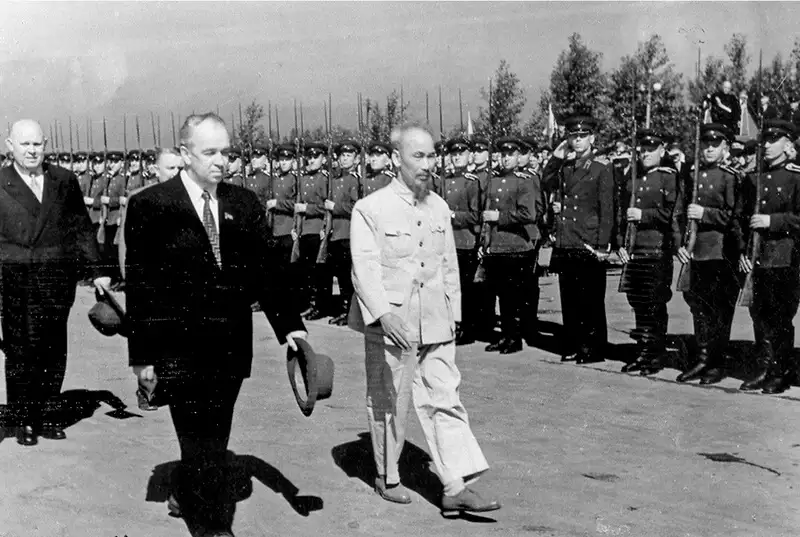
- Chairman Ho Chi Minh during a visit and work session in the Soviet Union, symbolizing the cooperative relationship between the USSR and North Vietnam during the war. (Source: Collected)
Laos
Initially neutral in the conflict, Laos saw North Vietnamese troops move through its territory and support a communist uprising, prompting massive U.S. bombing campaigns.
In 1962, the U.S., both Vietnams, and several other nations signed an agreement to respect Laos’s neutrality and refrain from interfering in its affairs. However, North Vietnam soon violated this pact, deploying troops and transporting supplies through Laos instead of crossing the heavily guarded Demilitarized Zone (DMZ) separating North and South Vietnam.
North Vietnam also orchestrated a communist uprising against the monarchy of Prince Souvanna Phouma, turning the local communist forces into a “junior partner,” as Professor Moise describes it.
In response, the U.S. secretly launched a massive bombing campaign across Laos. Over nine years, with an average of one bombing run every eight minutes, Laos became the most heavily bombed country per capita in history. Unexploded ordnance from the Vietnam War era continues to kill and injure people in Laos (as well as Vietnam and Cambodia) to this day.
Meanwhile, in 1971, President Richard Nixon authorized a cross-border invasion into Laos. Despite these efforts, the U.S. failed to significantly disrupt North Vietnam’s supply lines or prevent Laos from falling to communist forces in 1975.
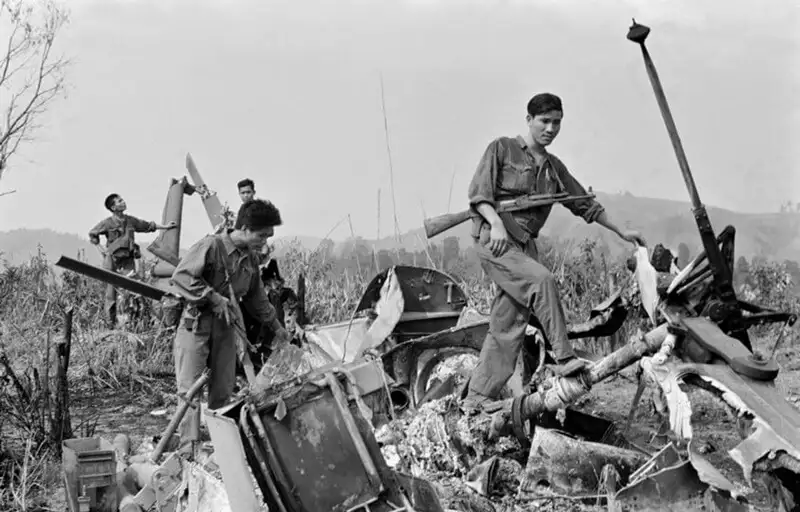
- Soldiers in Laos inspecting the wreckage of a downed aircraft, evidence of the fierce conflicts during the war. (Source: Collected)
Cambodia
Though officially neutral, Cambodia tolerated communist incursions and became a target of U.S. bombing due to these activities.
Unsurprisingly, North Vietnam also used Cambodia as a route to move troops and supplies. Despite its neutrality, Prince Norodom Sihanouk “felt surrounded by dangerous threats and was forced to maintain good relations with certain parties,” according to Professor Moise. He couldn’t afford to antagonize North Vietnam, though domestically he was “anti-communist.”
The U.S. responded with a secret bombing campaign, which President Richard Nixon significantly escalated in 1969. In 1970, Nixon sent troops across the border into Cambodia, capitalizing on a coup that ousted Sihanouk and installed a pro-U.S. military general.
U.S. bombings killed tens of thousands of Cambodians, and some historians argue this may have boosted support for the Khmer Rouge, a communist insurgency that later carried out a brutal genocide upon seizing power in 1975
Although Vietnamese communist forces allied with the Khmer Rouge during the Vietnam War, they ultimately overthrew the regime in 1979.

- Cambodian soldiers marching during the war period, reflecting the tension of a neutrality under threat. (Source: Collected)
South Korea and Other U.S. Allies
South Korea was a key partner of the U.S. and South Vietnam in the Vietnam War, contributing over 300,000 troops, of whom about 5,000 died.
The Johnson administration didn’t want the U.S. to appear “alone” in the war, so it pressured other nations to join, much like George W. Bush later formed a “coalition of the willing” in the Iraq War.
According to Professor Ed Moise, South Korean troops not only provided large numbers but were also renowned for fighting more fiercely than other U.S. allies. South Korea’s participation stemmed from a sense of duty and ideological empathy, as they saw historical parallels between themselves and South Vietnam. Additionally, South Korea received substantial economic and military aid from the U.S. as “compensation” for its involvement.
Financial aid and the desire to maintain good relations with the U.S. also drew other nations into the conflict. A genuine fear of communism’s spread further motivated participation.
As a result, nearly 60,000 Australian troops fought, with 521 deaths. About 40,000 Thai soldiers participated, with 321 fatalities, and over 3,000 New Zealand troops joined, losing 37 lives. The Philippines, Taiwan, and Spain also supported the U.S. war effort, while on the communist side, North Korea and Cuba reportedly offered symbolic assistance.

- South Korean soldiers preparing supplies during a campaign in Vietnam, highlighting their significant role in the Vietnam War. (Source: Collected)
Vietnam
The Vietnam War is often described as a civil war in South Vietnam, but in reality, it became a proxy war between Cold War superpowers. Consequently, the Vietnamese people suffered the heaviest toll in the conflict.
Brutal tactics became commonplace in the Vietnam War, and no one bore the consequences more than the Vietnamese themselves, in both the North and South. By 1975, when North Vietnamese forces entered Saigon and unified the country under communist rule, an estimated 1 to 3 million Vietnamese had died, including a vast number of civilians.
Conclusion
The Vietnam War was not merely a clash between North and South but a battlefield where powers like France, the U.S., China, and the Soviet Union intervened with their own motives. From France’s occupation and the U.S.’s escalation to the supportive roles of China and the Soviet Union, each nation left its mark on history. Pywar hopes this article provides a comprehensive overview, helping readers understand the context and profound impact of this war.
Translated by: Le Tuan
Source: History.com – Which Countries Were Involved in the Vietnam War?


